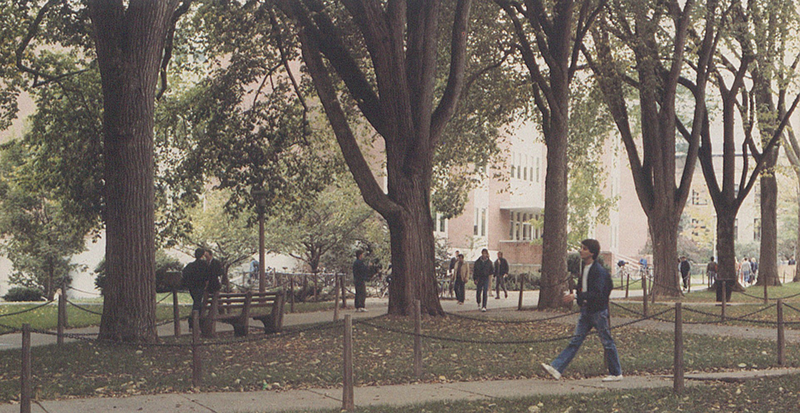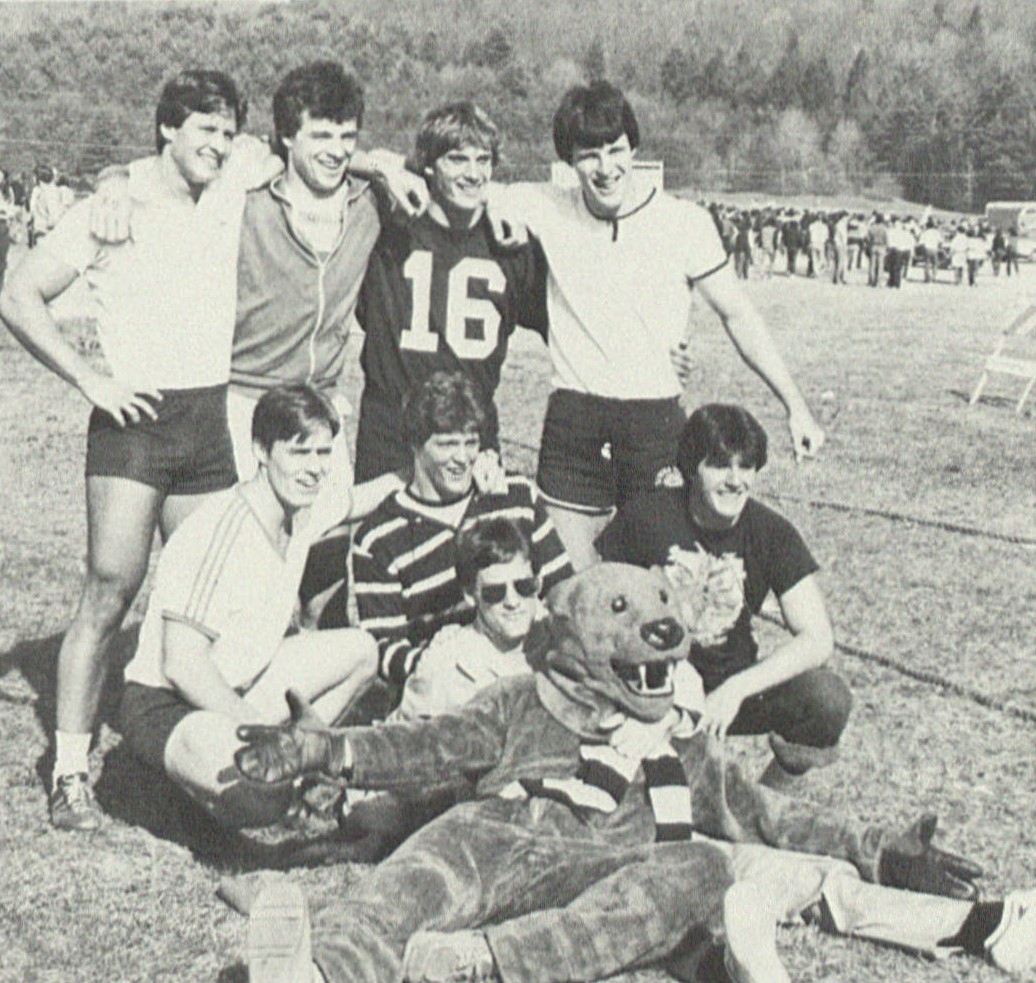By Greg Woodman
Reprinted from 1988 Football Preview
What are the distinct geographical boundaries of the area called Happy Valley? Is it just the Penn State campus, Beaver Stadium, College Avenue, and five bars with lots of memories?

If the area is growing as much as it appears, will Happy Valley soon be called “Big Valley” and lose all of its charm?
Is Happy Valley just an ordinary college town? Where did the title Happy Valley come from? Why does the name seem to be spreading? Nittany Valley would seem more catchy.
We’ve all heard or read the area’s common description: “Happy Valley, raw beauty, tranquilly situated amongst mountains equally inaccessible from everywhere—it’s bucolic.”
There are many college towns in nice places. And many warmer areas in the winter. Why the growing affection? Everyone who knows Happy Valley (and the ranks are swelling) loves to come back to this isolated and insulated womb.
In fact, the only changes that are really happening in Happy Valley are purely to accommodate the masses that are coming back to visit. The actual population in Centre County is surprisingly projected to grow at a rate of only one percent per year through the year 2000.
I believe the economic growth is coming from the dislocated Penn Staters who return to visit the land of Oz. The yellow brick road is either Rt. 22, 322, or 80. We all come back to see the wizard. For Penn Staters, Happy Valley is where we develop our courage, heart, and brains.
It’s Spring/Summer in the Valley. It’s the easiest time to talk about truly experiencing Happy Valley. Winter is now behind us.
Happy Valley is all of Central Pennsylvania. Sure, when I was a student it wasn’t more than one street, College Avenue. It took six months before I discovered Allen Street and Beaver Avenue; a year before I ventured across Atherton Street.
The real discoveries were after I graduated. Each year I discovered more; state parks, restaurants like the Old Oak Tavern and the Gamble Mill Tavern, Boalsburg’s Memorial Day, Centre Hall, Lemont, and all of the area’s lush golf courses! The feeling of discovery recurs each time I take a dislocated, or visiting, Penn Stater to somewhere other than the Tavern for dinner.
To their astonishment there is life beyond the three streets of State College. Most old college friends think I still hang out at the Skellar with my wife three times a week.
“You mean, you don’t still do a case of Rocks then hit the ‘Gaff for oldies on Thursdays?” an old fraternity brother asked.
I enjoy visits from old fraternity brothers because they are looking for what I affectionately refer to as a “TURN BACK THE CLOCK WEEKEND.” And yes. We turn back the clock for us to 1979.
It’s the old weekend rituals that all true Penn Staters know, remember, and love. My particular favorite was to stop, as I often did in my six years of college, and “smell the roses.” This is done in the area across from College Avenue behind Atherton Hall that has a slight hill to give “stadium-like viewing” of the action of College Avenue at 2:30 in the morning. There used to be a couple of rose bushes up there so we’d say “let’s go smell the roses.” Great place to go with a couple of slices from “The Cut Pie Shop!” This area grew in popularity for our group only (It’s not like climbing Mt. Nittany or sitting on the wall).
Many serious discussions were held there. Yes, the memories of the simpler and more idealistic times. Living among 35,000 17 to 22 year olds. Skipping along with a backpack on one shoulder and looking at all the scenery. Whistling “Sitting on the Dock of the Bay.” It was a great time. Living, loving and learning—college life!
It’s always fun to turn back the clock, but the locals know you can’t do it with your weekend visitors all of the time. And this is where Happy Valley separated itself from everywhere.
The “many-layer theory” comes into play. It’s fun to show my old college friends and family how much more there really is. I can’t describe it any better than the local writer Joan Kurilla: “Where else can one attend professional theatre, tour historic iron works, golf a championship bentgrass golf course, hike part of the Appalachian trail and visit a flock of newborn lambs.
Happy Valley is a kaleidoscope of life as it was and life as it can be…an ambivalence of jeans and black tie, Bach and rock, beer and Brie, raucous sports and serene resorts. It’s a place for all seasons, a space for all reasons.”
Origin of Happy Valley
The name Happy Valley first appeared in print in 1968. This being the 20th anniversary, and with Time magazine dedicating the cover recently to the mystique and nostalgia of 1968, this equally revered publication should also look back.
Summing up 1968, the articles and photos in “Time” illustrate “unresolved conflicts tearing at American life.” One college town, as usual, seemed isolated from the action. So in a mocking sort of way the “sleepy town” of State College was referred to as Happy Valley, in a student editorial.
“Newsweek” magazine, another of our publication colleagues, recently ran a cover story saying the 1990s are here. Based on “Newsweek’s” indicators, Happy Valley will be “in” more than ever. Greed is gone, yuppies dead.
To hear it from “Newsweek”, it’s once again hip to get together with old friends at the Skellar, wear your old letter sweater, picnic in the country with the family, eat big meals. This will be Happy Valley’s decade.
In 1968 another important first for Happy Valley occurred. Joe Paterno, in only his third year as head coach, led Penn State to its first undefeated year. Joe and Happy Valley both have grown in prominence and prestige in two decades. No question, Joe’s impact has spread the Happy Valley story. Just listen as football announcers Keith Jackson and Brent Musburger sing the praises of the area on a cool, crisp fall afternoon. The cameras pan the valley for the whole country to see.
Not to imply that the area’s growth was based solely on football’s success. Mr. Paterno would be the first to say his love for this area was a factor prompting him to turn down millions to move to New England.
Tuscaloosa, South Bend, Norman, and other famous college football towns are not in economic boom periods. You can safely say that Joe Paterno let the cat, or the Nittany Lion, out of the bag. First he told the story to parents of recruits. Then his teams’ efforts spread the word to the rest of the world.
Not only is it number one in the hearts of more than 200,000 living Penn State graduates, Happy Valley is also the darling of the state of Pennsylvania.
Black Mondays, grinding poverty, unscrupulous agents and recessions just don’t seem to find their way up the winding roads. It’s kind of like Switzerland.
Two other anniversaries that point to the late ‘60’s influence. The Arts Festival began in 1966 and the Lion Country Visitor’s Bureau began in 1963 (now the HappyValley Adventure Bureau).
The festival draws in more than 300,000 people every July and more than $20 million. As for the tourist bureau, they either have the easiest job in America or should be paid a bonus.
Don’t be alarmed by the changes in the valley. At closer look you’ll see an Andy Hardy movie set in the 1930’s.
Well, it’s springtime and the roses are smelling good. So, click your heels three times and key saying, “There’s no place like Happy Valley…There’s no place like Happy Valley.”


